wheel size LEXUS LS430 2006 Owners Manual
[x] Cancel search | Manufacturer: LEXUS, Model Year: 2006, Model line: LS430, Model: LEXUS LS430 2006Pages: 419, PDF Size: 11.19 MB
Page 158 of 419

142
2-4. Using other driving systems
CAUTION
Any of the following conditions may result in-an accident which could cause death
or serious injury:
■The ABS may not operate effectively when:
●The limits of tire gripping performance have been exceeded.
●If the vehicle hydroplanes while driving at high speed while the road is wet or
slick.
■Stopping distance when the ABS is activated will exceed that of normal condi -
tions
The ABS is not designed to shorten the v
ehicle’s stopping distance. Always main -
tain a safe distance between you and the vehicle in front of you, particularly in the
fo
llowing situations.
• When driving on dirt, gravel or snow-covered roads
• When driving with tire chains
• When driving over bumps in the road
• When driving over roads with potholes or uneven roads
• When towing a trailer
■TRAC may not operate effectively when:
Directional control and power may not be ac hi
evable while driving on slippery road
surfaces, even if the TRAC system is operating.
Do not drive the vehicle in conditions where control and power may be lost.
■When the slip indicator flashe s and a warning buzzer sounds
This situation occurs immediately before VSC is activated. Always drive carefully.
R
eckless driving may cause an at the recommended level.
Exercise particular care when an indicator light flashes and a buzzer sounds.
■Replacing tires
Ensure that all tires are the same size an d
brand, have the same tread pattern, and
that the level of tire pressure is at the recommended level.
The ABS and VSC systems may not operate no rmal
ly if different tires are installed
to the vehicle.
Contact your Lexus dealer for further info rmati
on when replacing tires or wheels.
Page 165 of 419
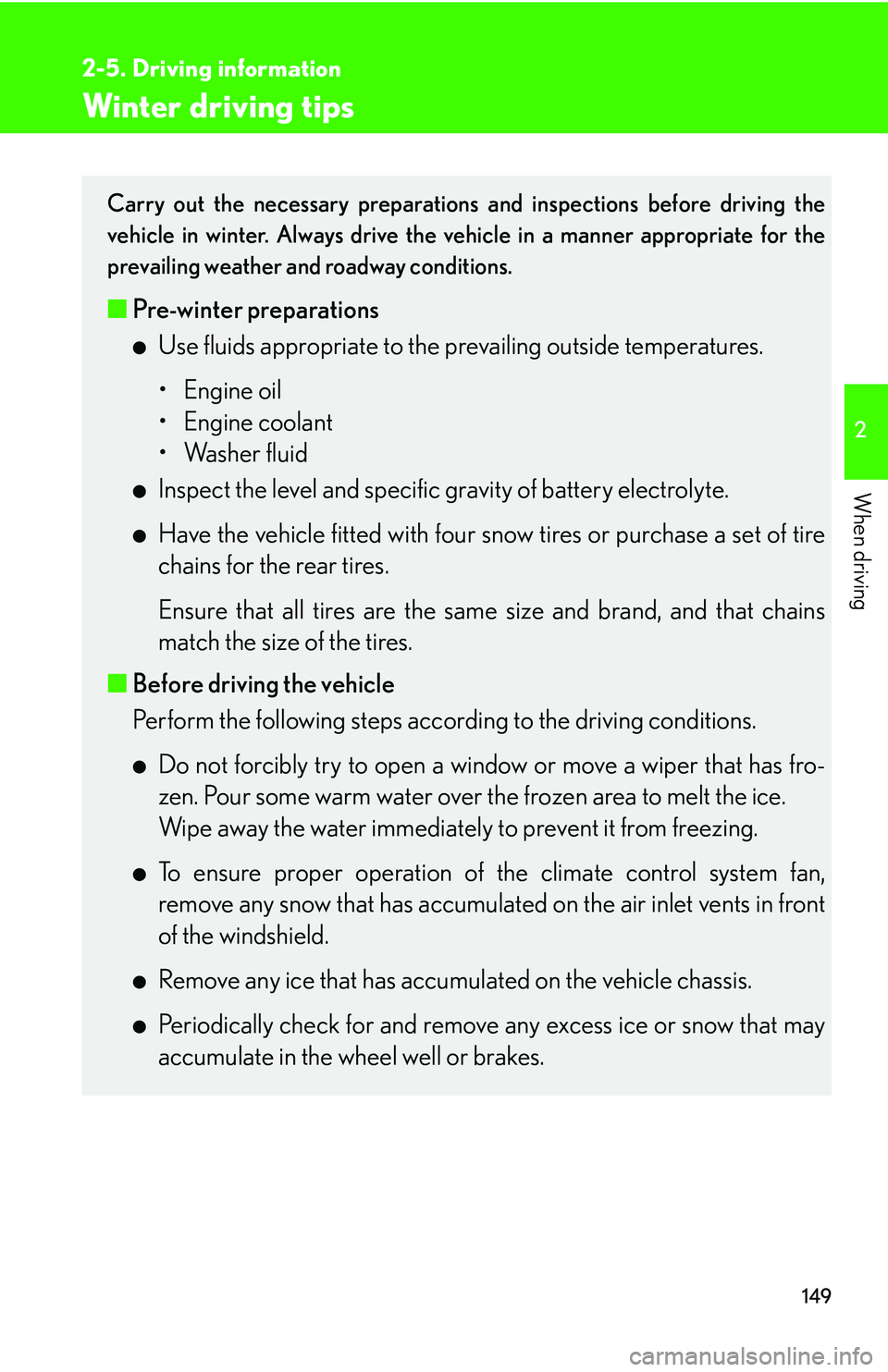
149
2-5. Driving information
2
When driving
Winter driving tips
Carry out the necessary preparations and inspections before driving the
vehicle in winter. Always drive the vehicle in a manner appropriate for the
prevailing weather and roadway conditions.
■ Pre-winter preparations
●Use fluids appropriate to the p revailing outside temperatures.
• Engine oil
• Engine coolant
• Washer fluid
●Inspect the level and specific gravity of battery electrolyte.
●Have the vehicle fitted with four sno w tires or purchase a set of tire
chains for the rear tires.
Ensure that all tires are the same si
ze and brand, and that chains
match the size of the tires.
■ Befor
e driving the vehicle
Perform the following steps acco r
ding to the driving conditions.
●Do not forcibly try to open a window or move a wiper that has fro-
zen. Pour some warm water over the frozen area to melt the ice.
Wipe away the water immediately to pr
event it from freezing.
●To ensure proper operation of the climate control system fan,
remove any snow that has accumulated on the air inlet vents in front
of the windshield.
●Remove any ice that has accumulated on the vehicle chassis.
●Periodically check for and remove any excess ice or snow that may
accumulate in the wheel well or brakes.
Page 167 of 419
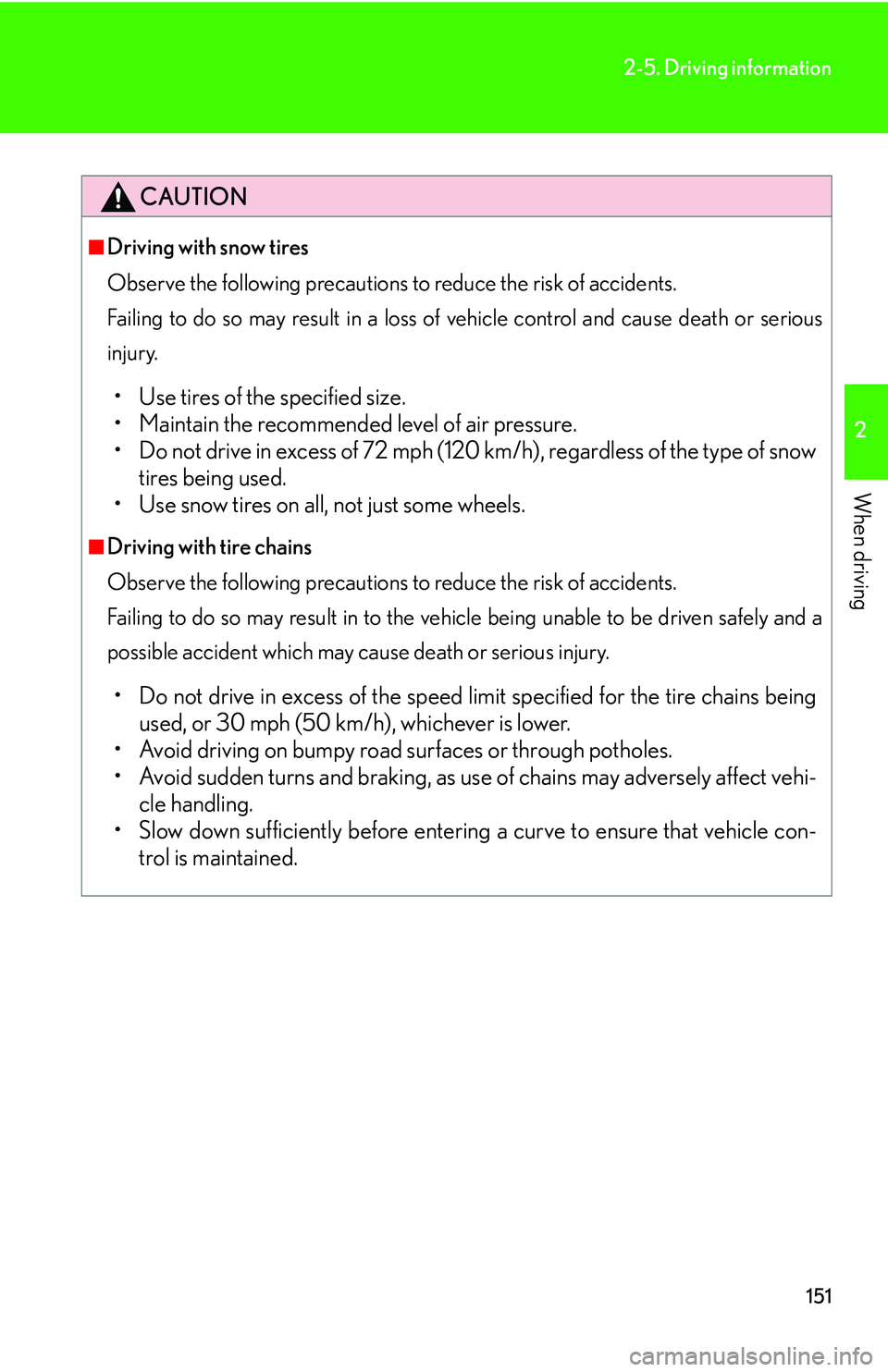
151
2-5. Driving information
2
When driving
CAUTION
■Driving with snow tires
Observe the following precautions to reduce the risk of accidents.
Failing to do so may result in a loss of vehicle control and cause death or serious
injur
y.
• Use tires of the specified size.
• Maintain the recommended level of air pressure.
• Do not drive in excess of 72 mph (120 km/h), regardless of the type of snow tir
es being used.
• Use snow tires on all, not just some wheels.
■Driving with tire chains
Observe the following precautions to reduce the risk of accidents.
Failing to do so may result in to the vehicle being unable to be driven safely and a
p
ossible accident which may cause death or serious injury.
• Do not drive in excess of the speed limit specified for the tire chains being
used, or 30 mph (50 km/h), whichever is lower.
• Avoid driving on bumpy road s
urfaces or through potholes.
• Avoid sudden turns and braking, as us e of chains may a
dversely affect vehi-
cle handling.
• Slow down sufficiently before entering a curve to ensure that vehicle con -
trol is maintained.
Page 297 of 419
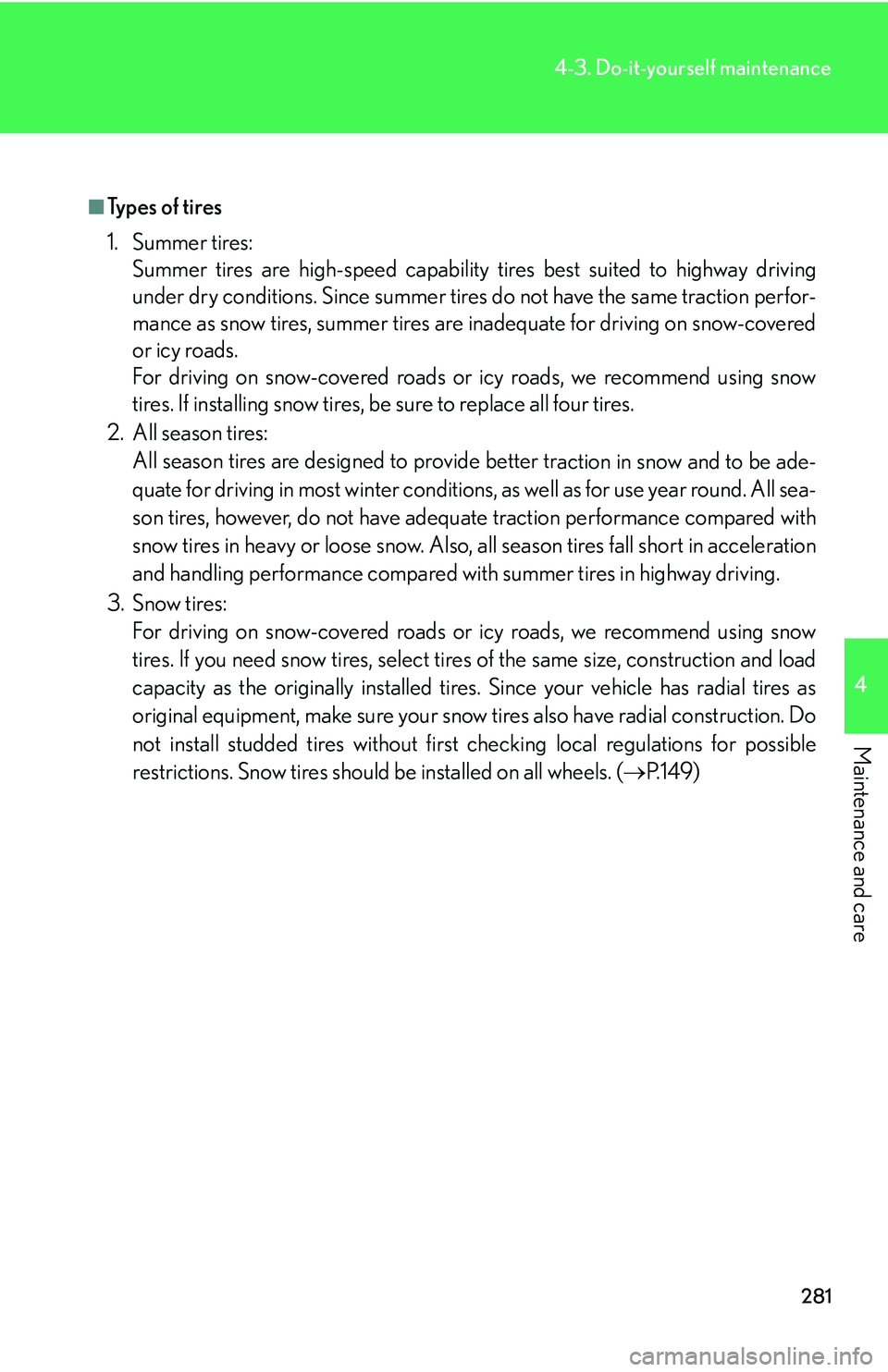
281
4-3. Do-it-yourself maintenance
4
Maintenance and care
■Ty p e s o f t i r e s
1. Summer tires:
Summer tires are high-speed capability tires best suited to highway driving
un
der dry conditions. Since summer tires do not have the same traction perfor-
mance as snow tires, summer tires are in adequate f
or driving on snow-covered
or icy roads.
For driving on snow-covered roads or icy roads, we recommend using snow
t
ires. If installing snow tires, be sure to replace all four tires.
2. All season tires:
All season tires are designed to provid e better tr
action in snow and to be ade-
quate for driving in most winter conditions , as
well as for use year round. All sea-
son tires, however, do not have adequa te
traction performance compared with
snow tires in heavy or loose snow. Also, a ll season tires fall short in acceleration
and handling performance compared wi th summer tires in highway driving.
3. Snow tires:
For driving on snow-covered roads or icy roads, we recommend using snow
tir
es. If you need snow tires, select tire s of the same size, construction and load
capacity as the originally installed tires. Since your vehicle has radial tires as
original equipment, make sure your snow tires also have radial construction. Do
not install studded tires without first checking local regulations for possible
restrictions. Snow tires should be installed on all wheels. (P.149 )
Page 298 of 419

282
4-3. Do-it-yourself maintenance
+
CAUTION
■When inspecting or replacing tires
Observe the following instructions, as failure to do so may cause dangerous han-
dling characteristics resulting in loss of contr
ol and could cause death or serious
injury.
• Do not mix radial, bias belted, or bias-ply tir
es on your vehicle, or use tires other
than the manufacturer’s recommended size.
• Do not mix summer and all season tires on your vehicle.
• Do not use tires other than the manufact ur
er’s designated tires, and never mix
tires or wheels of different size to the originals.
NOTICE
■To prevent malfunction of the tire pressure warning system
Do not push the reset switch without adjusting the tire inflation pressure to the spec-
ified level. Otherwise, the low tire pressure warning may not function correctly.
( P.334 )
■If tire pressure becomes low while driving
Do not continue driving, your ti r
es and/or wheels may be ruined.
Page 303 of 419
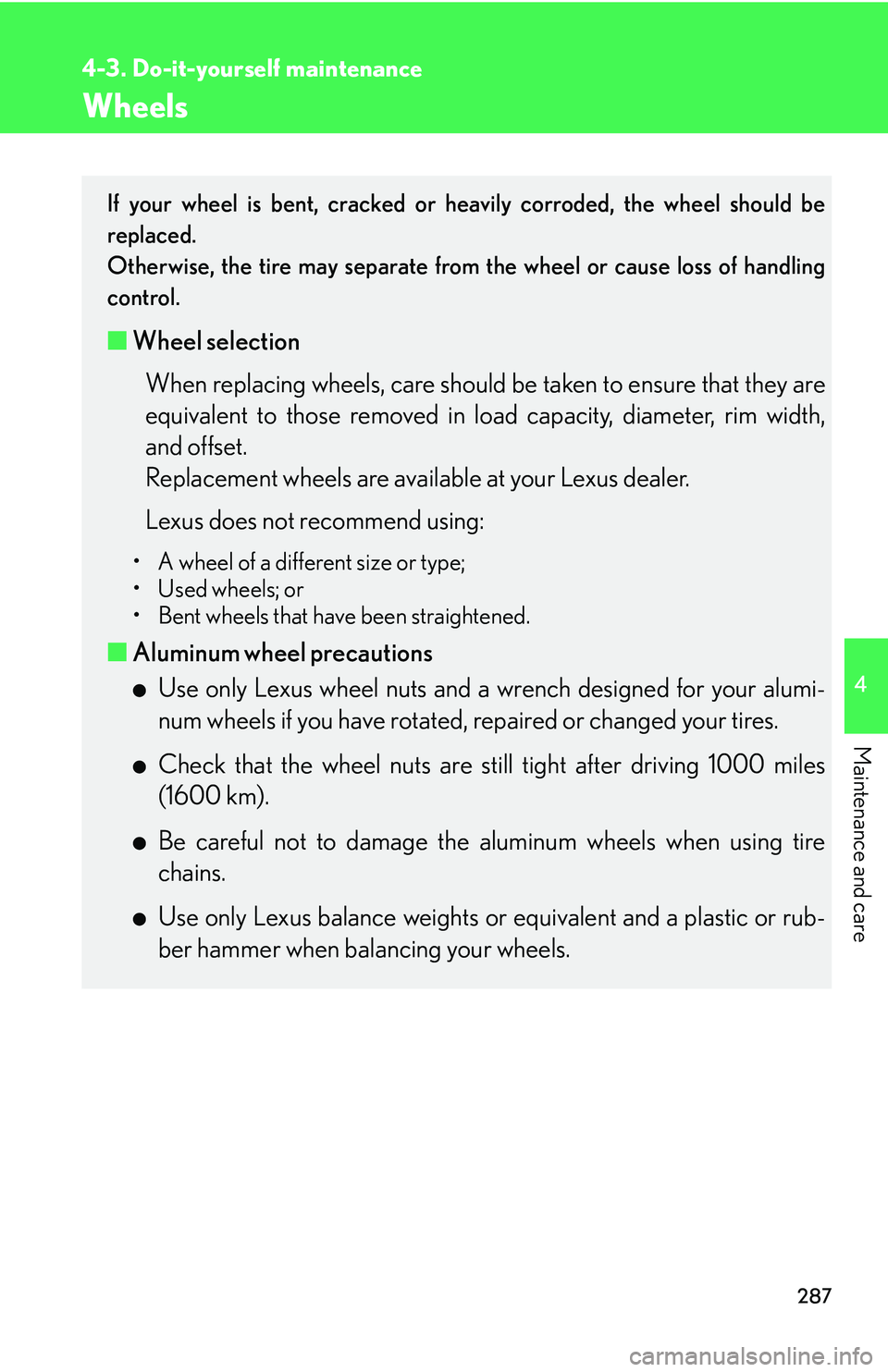
287
4-3. Do-it-yourself maintenance
4
Maintenance and care
Wheels
If your wheel is bent, cracked or heavily corroded, the wheel should be
replaced.
Otherwise, the tire may separate from t
he wheel or cause loss of handling
control.
■ Wheel selection
When replacing wheels, care should be tak
en to ensure that they are
equivalent to those removed in lo ad capacity, diameter, rim width,
and offset.
Replacement wheels are available at your Lexus dealer.
Lexus does not recommend using:
• A wheel of a different size or type;
• Used wheels; or
• Bent wheels that have been straightened.
■ Aluminum wheel precautions
●Use only Lexus wheel nuts and a wrench designed for your alumi-
num wheels if you have rotated, repaired or changed your tires.
●Check that the wheel nuts are st ill tight after driving 1000 miles
(1600 km).
●Be careful not to damage the aluminum wheels when using tire
chains.
●Use only Lexus balance weights or equivalent and a plastic or rub-
ber hammer when balancing your wheels.
Page 304 of 419

288
4-3. Do-it-yourself maintenance
CAUTION
■When replacing wheels
●Do not use wheels other than the manufacturer’s recommended wheel or wheel
size, as this may result in loss of handling control.
●Never using an inner tube in a leaking wheel which is designed for a tubeless tire.
Doing so may result in an accident, causing death or serious injury.
Page 358 of 419
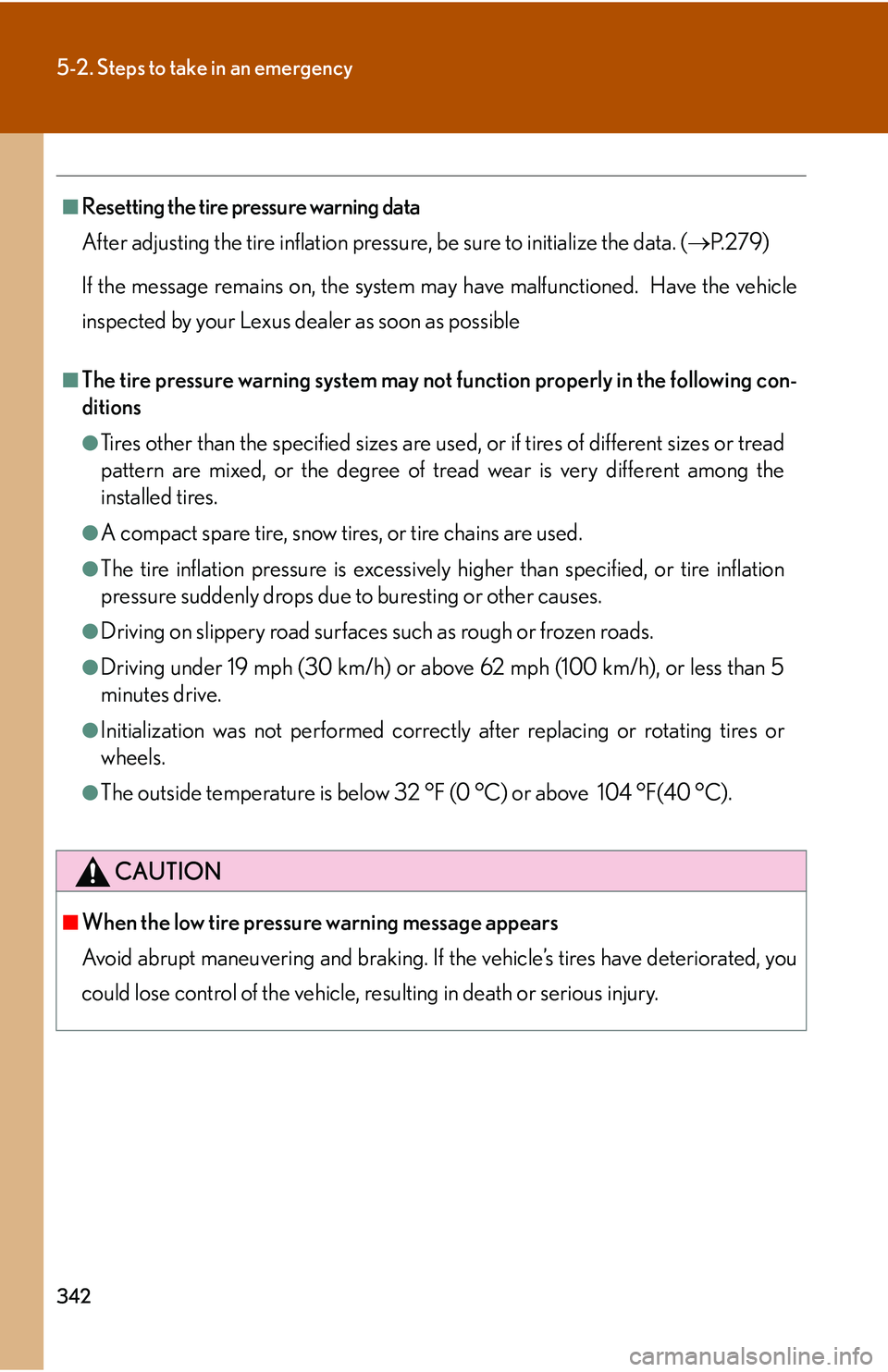
342
5-2. Steps to take in an emergency
■Resetting the tire pressure warning data
After adjusting the tire inflation pressur
e, be sure to initialize the data. (P. 2 7 9 )
If the message remains on, the system may have malfunctioned. Have the vehicle
inspected b
y your Lexus dealer as soon as possible
■The tire pressure warning system may not function properly in the following con -
ditions
●Tires other than the sp ecified sizes are used, or if tires of different sizes or tread
pattern are mixed, or the degree of tread wear is very different among the
installed tires.
●A compact spare tire, snow tires, or tire chains are used.
●The tire inflation pressure is excessively higher than specified, or tire inflation
pressure suddenly drops due to buresting or other causes.
●Driving on slippery road surfaces such as rough or frozen roads.
●Driving under 19 mph (30 km/h) or above 62 mph (100 km/h), or less than 5
minutes drive.
●Initialization was not performed correctly after replacing or rotating tires or
wheels.
●The outside temperature is below 32 °F (0 °C) or above 104 °F(40 °C).
CAUTION
■When the low tire pressure warning message appears
Avoid abrupt maneuvering and braking. If th
e vehicle’s tires have deteriorated, you
could lose control of the vehicle, resulting in death or serious injury.
Page 386 of 419
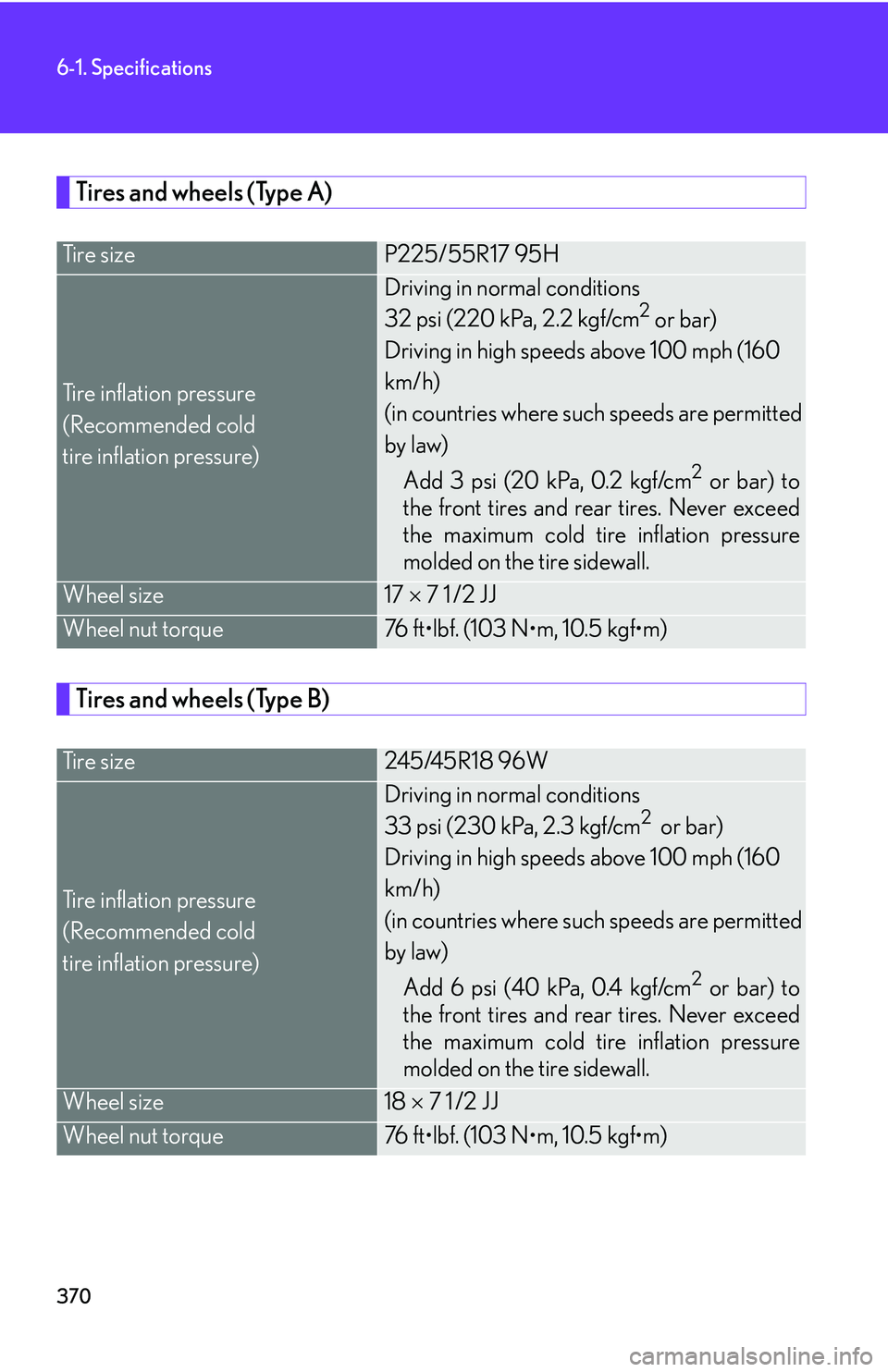
370
6-1. Specifications
Tires and wheels (Type A)
Tires and wheels (Type B)
Ti r e s i z eP225/55R17 95H
Tire inflation pressure
(Recommended cold
tire inflation pressure)
Driving in normal conditions
32 psi (220 kPa, 2.2 kgf/cm2 or bar)
Driving in high speeds above 100 mph (160
km/
h)
(in countries where such speeds are permitted
b
y law)
Add 3 psi (20 kPa, 0.2 kgf/cm
2 or bar) to
the front tires and rear tires. Never exceed
the maximum cold tire inflation pressure
molded on the tire sidewall.
Wheel size17 7 1 /2 JJ
Wheel nut torque76 f t•lbf. (103 N•m, 10.5 kgf•m)
Ti r e s i z e245/45R18 96W
Tire inflation pressure
(Recommended cold
tire inflation pressure)
Driving in normal conditions
33 psi (230 kPa, 2.3 kgf/cm2 or bar)
Driving in high speeds above 100 mph (160
km/
h)
(in countries where such speeds are permitted
b
y law)
Add 6 psi (40 kPa, 0.4 kgf/cm
2 or bar) to
the front tires and rear tires. Never exceed
the maximum cold tire inflation pressure
molded on the tire sidewall.
Wheel size18 7 1 /2 JJ
Wheel nut torque76 f t•lbf. (103 N•m, 10.5 kgf•m)
Page 387 of 419

371
6-1. Specifications
6
Vehicle specifications
Tires and wheels (Type C)
Ti r e s i z eP245/45R18 96V
Tire inflation pressure
(Recommended cold
tire inflation pressure)
Driving in normal conditions
33 psi (230 kPa, 2.3 kgf/cm2 or bar)
Driving in high speeds above 100 mph (160
km/
h)
(in countries where such speeds are permitted
b
y law)
Add 6 psi (40 kPa, 0.4 kgf/cm
2 or bar) to
the front tires and rear tires. Never exceed
the maximum cold tire inflation pressure
molded on the tire sidewall.
Wheel size18 7 1 /2 JJ
Wheel nut torque76 f t•lbf. (103 N•m, 10.5 kgf•m)